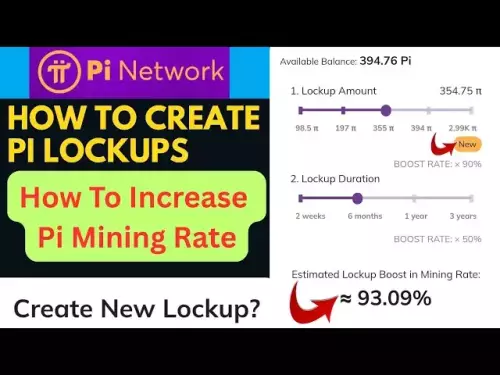-
 bitcoin
bitcoin $114779.865156 USD
2.30% -
 ethereum
ethereum $4226.519789 USD
2.39% -
 tether
tether $1.000545 USD
0.04% -
 xrp
xrp $2.890223 USD
0.92% -
 bnb
bnb $1030.029301 USD
2.95% -
 solana
solana $212.824944 USD
1.69% -
 usd-coin
usd-coin $0.999757 USD
0.01% -
 dogecoin
dogecoin $0.234961 USD
-0.27% -
 tron
tron $0.337174 USD
0.42% -
 cardano
cardano $0.804783 USD
0.09% -
 hyperliquid
hyperliquid $45.748770 USD
-2.85% -
 chainlink
chainlink $21.699170 USD
0.82% -
 ethena-usde
ethena-usde $1.001452 USD
0.08% -
 avalanche
avalanche $30.237800 USD
1.14% -
 stellar
stellar $0.372604 USD
1.52%
Guide for small investors to turn the tables: How to make 500,000 yuan with 5,000 yuan without exploding
To turn 5,000 yuan into 500,000 yuan, adopt disciplined strategies like Dollar-Cost Averaging, staking, and cautious altcoin investments, while managing risks effectively.
Jun 06, 2025 at 03:00 pm

Introduction to Small Investment Strategies
Investing in the cryptocurrency market with a small amount of capital, such as 5,000 yuan, and aiming to turn it into 500,000 yuan, is a daunting task that requires careful planning and execution. The key to success lies in adopting a disciplined approach and understanding the market dynamics. This guide will provide small investors with actionable strategies to maximize their returns without taking undue risks that could lead to a complete loss of their investment.
Understanding the Cryptocurrency Market
Before diving into specific strategies, it's crucial to have a solid understanding of the cryptocurrency market. Cryptocurrencies are highly volatile assets that can experience significant price swings within short periods. This volatility can be both a risk and an opportunity for small investors. By staying informed about market trends, news, and technological developments, investors can make more informed decisions.
Setting Realistic Goals and Risk Management
Setting realistic goals is fundamental to achieving long-term success in the cryptocurrency market. Aiming to turn 5,000 yuan into 500,000 yuan is an ambitious goal, but it's achievable with the right approach. One of the most critical aspects of investing is risk management. Small investors should never invest more than they can afford to lose and should diversify their investments to mitigate risk.
Strategy 1: Dollar-Cost Averaging (DCA)
Dollar-Cost Averaging is a strategy that involves investing a fixed amount of money at regular intervals, regardless of the market's performance. This approach helps to reduce the impact of volatility and allows investors to buy more cryptocurrency when prices are low and less when prices are high. For a small investor starting with 5,000 yuan, DCA can be an effective way to build a position over time without risking a large sum all at once.
- Determine your investment amount and frequency: Decide how much you can afford to invest each month. For example, if you can invest 500 yuan per month, you will be able to invest for 10 months with your initial 5,000 yuan.
- Choose a cryptocurrency: Select a cryptocurrency that you believe has long-term potential. Bitcoin and Ethereum are popular choices due to their established track records.
- Set up automatic investments: Many exchanges offer the ability to set up automatic recurring purchases, making it easier to stick to your DCA plan.
Strategy 2: Staking and Yield Farming
Staking and yield farming are ways to earn passive income on your cryptocurrency holdings. Staking involves holding your cryptocurrency in a wallet to support the operations of a blockchain network, while yield farming involves lending your cryptocurrency to others in exchange for interest. Both methods can help small investors grow their investments over time.
- Research staking and yield farming opportunities: Look for platforms that offer staking and yield farming services. Some popular options include Coinbase, Binance, and decentralized finance (DeFi) platforms like Aave and Compound.
- Choose a suitable cryptocurrency: Not all cryptocurrencies support staking or yield farming. For example, you can stake Ethereum 2.0 or earn yield on stablecoins like DAI.
- Set up your staking or yield farming account: Follow the platform's instructions to deposit your cryptocurrency and start earning rewards.
Strategy 3: Trading with Leverage
Trading with leverage can amplify your returns, but it also increases the risk of significant losses. Small investors should approach leverage trading with caution and only use it if they have a solid understanding of the market and trading strategies. Leverage allows you to borrow funds to increase your trading position, but it can lead to liquidation if the market moves against you.
- Choose a reputable exchange: Select an exchange that offers leverage trading, such as Binance or Bybit.
- Educate yourself on leverage trading: Understand how leverage works and the risks involved. Start with small amounts and gradually increase your exposure as you gain experience.
- Use stop-loss orders: Implement stop-loss orders to limit your potential losses. A stop-loss order automatically sells your position if the price reaches a certain level.
Strategy 4: Investing in Altcoins
Investing in altcoins, or alternative cryptocurrencies, can offer higher potential returns than established cryptocurrencies like Bitcoin and Ethereum. However, altcoins are often more volatile and riskier. Small investors should conduct thorough research before investing in altcoins and should only allocate a small portion of their portfolio to these assets.
- Research promising altcoins: Look for projects with strong fundamentals, a clear roadmap, and an active development team. Websites like CoinMarketCap and CoinGecko can help you find information on various altcoins.
- Diversify your altcoin investments: Instead of putting all your money into one altcoin, spread your investments across several promising projects to reduce risk.
- Monitor your investments: Keep an eye on the performance of your altcoins and be prepared to sell if the project fails to meet its milestones or if the market turns against it.
Strategy 5: Participating in Initial Coin Offerings (ICOs) and Initial DEX Offerings (IDOs)
Participating in ICOs and IDOs can be a way to get in on the ground floor of new projects and potentially achieve high returns. However, these investments are highly speculative and carry significant risk. Small investors should only allocate a small portion of their capital to ICOs and IDOs and should conduct thorough due diligence before investing.
- Research upcoming ICOs and IDOs: Look for projects that are conducting token sales. Websites like ICOBench and CoinList can provide information on upcoming ICOs and IDOs.
- Evaluate the project's whitepaper and team: Read the project's whitepaper to understand its goals and technology. Research the team behind the project to ensure they have the expertise and experience to execute their plan.
- Participate in the token sale: Follow the instructions on the project's website to participate in the token sale. Be aware of the risks and only invest what you can afford to lose.
Frequently Asked Questions
Q: How long will it take to turn 5,000 yuan into 500,000 yuan using these strategies?A: The time it takes to achieve this goal will vary depending on market conditions and the specific strategies you use. Dollar-Cost Averaging and staking can take several years to reach such high returns, while trading with leverage and investing in altcoins may offer quicker but riskier returns.
Q: Is it possible to achieve this goal without using leverage?A: Yes, it is possible to achieve this goal without using leverage by combining strategies like Dollar-Cost Averaging, staking, and investing in altcoins. However, it may take longer and require a more conservative approach.
Q: What are the risks of investing in ICOs and IDOs?A: Investing in ICOs and IDOs carries significant risks, including the potential for the project to fail, scams, and regulatory issues. Small investors should only allocate a small portion of their capital to these investments and conduct thorough due diligence.
Q: How can I stay informed about the cryptocurrency market?A: Staying informed about the cryptocurrency market involves regularly reading news from reputable sources, following market analysis from experts, and participating in online communities and forums. Websites like CoinDesk, CryptoSlate, and Reddit's r/CryptoCurrency can provide valuable insights and updates.
Disclaimer:info@kdj.com
The information provided is not trading advice. kdj.com does not assume any responsibility for any investments made based on the information provided in this article. Cryptocurrencies are highly volatile and it is highly recommended that you invest with caution after thorough research!
If you believe that the content used on this website infringes your copyright, please contact us immediately (info@kdj.com) and we will delete it promptly.
- Meme Coins, October 2025: Best Buys for the Savvy Crypto Investor
- 2025-09-30 12:25:14
- Bitcoin ETF Net Flows: Fueling Developers and Shaping Markets
- 2025-09-30 12:25:14
- Algorand (ALGO) and Proof-of-Stake: Is This the Sleeping Giant?
- 2025-09-30 12:30:01
- QuantNet, Tokenized Money, and Digital Assets: A New Era for Banking
- 2025-09-30 12:45:12
- Rabby Wallet, Statistics, and 2025 Trends: What's the Buzz?
- 2025-09-30 12:30:01
- BullZilla: Meme Coin Primed for Market Takeover?
- 2025-09-30 12:30:01
Related knowledge

Practical parameter settings for a Bitcoin multi-timeframe moving average system
Sep 18,2025 at 10:54pm
Optimizing Timeframe Combinations for Bitcoin Trading1. Selecting appropriate timeframes is crucial when building a multi-timeframe moving average sys...

How can I filter out false breakouts in Dogecoin high-frequency trading?
Sep 22,2025 at 01:00am
Understanding False Breakouts in Dogecoin Trading1. A false breakout occurs when Dogecoin's price appears to move beyond a defined support or resistan...

Techniques for identifying tops and bottoms in the Bitcoin on-chain NVT model
Sep 20,2025 at 07:54pm
Understanding the NVT Model in Bitcoin Analysis1. The Network Value to Transactions (NVT) ratio is often described as the 'P/E ratio' of the cryptocur...

What does the surge in open interest in Bitcoincoin futures mean?
Sep 20,2025 at 11:18pm
Understanding the Surge in Dogecoin Futures Open Interest1. A surge in open interest within Dogecoin futures indicates a growing number of active cont...

How can I use the Ethereum USDT premium to gauge market sentiment?
Sep 18,2025 at 11:55pm
Understanding the Ethereum USDT Premium1. The Ethereum USDT premium refers to the price difference between USDT (Tether) traded on Ethereum-based plat...

What should I do if Ethereum staking yields decline?
Sep 20,2025 at 06:18am
Understanding the Causes Behind Declining Ethereum Staking Yields1. The Ethereum network transitioned to a proof-of-stake consensus mechanism with the...

Practical parameter settings for a Bitcoin multi-timeframe moving average system
Sep 18,2025 at 10:54pm
Optimizing Timeframe Combinations for Bitcoin Trading1. Selecting appropriate timeframes is crucial when building a multi-timeframe moving average sys...

How can I filter out false breakouts in Dogecoin high-frequency trading?
Sep 22,2025 at 01:00am
Understanding False Breakouts in Dogecoin Trading1. A false breakout occurs when Dogecoin's price appears to move beyond a defined support or resistan...

Techniques for identifying tops and bottoms in the Bitcoin on-chain NVT model
Sep 20,2025 at 07:54pm
Understanding the NVT Model in Bitcoin Analysis1. The Network Value to Transactions (NVT) ratio is often described as the 'P/E ratio' of the cryptocur...

What does the surge in open interest in Bitcoincoin futures mean?
Sep 20,2025 at 11:18pm
Understanding the Surge in Dogecoin Futures Open Interest1. A surge in open interest within Dogecoin futures indicates a growing number of active cont...

How can I use the Ethereum USDT premium to gauge market sentiment?
Sep 18,2025 at 11:55pm
Understanding the Ethereum USDT Premium1. The Ethereum USDT premium refers to the price difference between USDT (Tether) traded on Ethereum-based plat...

What should I do if Ethereum staking yields decline?
Sep 20,2025 at 06:18am
Understanding the Causes Behind Declining Ethereum Staking Yields1. The Ethereum network transitioned to a proof-of-stake consensus mechanism with the...
See all articles










































































